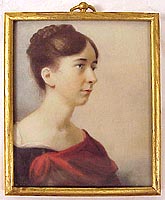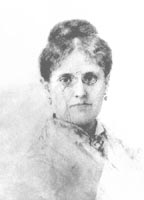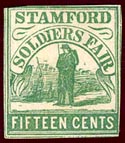| Join | Official Historian | City of Stamford | Blog | About Us | |
| Jewish Historical Society | Civil War Roundtable | Contact Us | |
|
|
|
|
The Stamford Historical Society PresentsStamford's
Civil War: At Home and in the Field
|
 Mary Ann Walker Dickinson, the later Mrs. Truman Smith. Miniature by Anson Dickinson |
Formed in July 1861, the ladies organized a fund-raiser in August, a Promenade Concert. Mrs. Truman Smith, president of the Society, arranged for shipments of goods to the David's Island hospital, and for visits of members of the Society to the Island. Few names of other members are available. A Mrs. Hoyt, Miss Aiken and Mrs. Baldwin are mentioned. Women of the Baptist, Congregational, Episcopal, and Presbyterian churches were involved in these efforts. When the ladies found their contributions were not always safely delivered, they organized their own deliveries and hand-carried baskets of food and boxes of clothing, apparently by boat down Long Island Sound. When visiting on the Island, the women wrote letters, made note of problems with wages and mail, read aloud to the patients, and did whatever they could to be helpful.
 Miss Catharine Aiken |
Serving in the Stamford Ladies Soldiers' Aid Society was for many women a genuine learning experience. The organizers gained skills that they later used in community service and provided leadership for other women. Women's groups in churches were strengthened and they learned to work cooperatively for the community good. Efforts even in the political field followed this beginning.
Patients In Hospital At David's Island
Men on David's Island, in addition to their physical suffering, had the usual soldiers' complaints. No mail- frequently the family had completely lost track of the soldier. It had not been advised of his whereabouts, may not have known that he was wounded, and may even have been advised that he had died. No clothes- his uniform and everything he owned was left on the battlefield or lost at the field hospital. Wrapped in a scrap of blanket, he had lost all dignity. A change of clothing and shaving supplies made him feel a human being again.
The Stamford ladies brought clothing, personal supplies, and homemade food to supplement the everyday diet. They passed out these items personally and stopped to visit the patients. They sat down to write a letter home, and to learn the particulars of the late-wages problems and the difficulties in filing for a discharge.
In return, the men wrote letters of thanks, their families wrote their own thanks to the Stamford ladies, via Mrs. Smith, and sometime they wrote to Mrs. Smith asking for her help in following some government process. Soldiers' pay was frequently late, their papers were misplaced and finding the proper official to contact was not always easy. Mrs. Smith had additional ability to lend aid since her husband was one of Connecticut's senators at the time.
Civil
War Medicine
The Sanitary Commission
Stamford Sanitary Fair And Stamp
In Seeley's Hall on Main Street on July 25, 1864, the Stamford Ladies Soldiers' Aid Society held a "Grand Fair." This Sanitary Fair was a benefit to raise money for the purchase of medical supplies for the relief on sick and wounded men in Union Civil War Hospitals. The need was desperate and at such Fairs several northern cities issued stamps like Stamford's. Other cities that also issued stamps were Albany, Brooklyn, New York City, Boston, Springfield, Massachusetts, and Philadelphia.
Seeley's Hall was decorated with flags and greens. A post office staffed by attractive young ladies sold stamps. Bearing a design of an artillery section with a sentinel resting on his musket, the stamp was inscribed with the words "Stamford Soldiers' Fair Fifteen Cents."
 Designed
by an unknown artist, the stamp was printed by a Mr. Campbell. The original
lithographed stamp was printed in violet-brown ink in sheets of eight. This
stamp was later reproduced on various colored papers. Today even copies are
rare. The Stamford Historical Society has one copy.
Designed
by an unknown artist, the stamp was printed by a Mr. Campbell. The original
lithographed stamp was printed in violet-brown ink in sheets of eight. This
stamp was later reproduced on various colored papers. Today even copies are
rare. The Stamford Historical Society has one copy.
The Sanitary Fair in Stamford lasted three days and netted $3,000, a considerable sum of money for the time and for the location, a modest village.
Stamps issued at Sanitary Fairs were not the usual postage stamp. They appear to have been intended for drop letter use at fairs and bazaars. Drop letters were deposited at the post offices to be called for by the addressee. No service to the sender or addressee was performed outside the post office. Carrier fees were covered by carrier stamps. The fee paid for delivery to or from the post office, within the city only.
 Sanitary
Fairs:
Sanitary
Fairs:
A Philatelic and Historical Study of Civil War Benevolences
by Alvin Robert Kantor, Marjorie S. Kantor
Hardcover: 304 pages
Sf Pub; August 1992
ISBN: 0963260308